Have You Heard About a Mixed Six Task?
In the spring of 2022, I was looking for some innovative ways to review my AP® Calculus students for the AP® exam. I read Peter Liljedahl’s book, “Building Thinking Classrooms in Mathematics,” in the summer of 2021 and decided to implement some of the strategies from his book. My calculus classes did numerous thin-slicing tasks in random groups at our VNPSs (vertical nonpermanent surfaces — aka white boards on the wall) throughout the 2021–22 school year. I was convinced that these strategies were making a huge difference in the actual understanding of calculus by my students. My students were talking about mathematics and finally accepting that calculus is not memorization and imitative calculations. I am so excited to introduce you to the why and how of Mixed Six activities.
I happened to be on Twitter one Saturday morning in early March and saw a post by Ben Gordon (@mathsmrgordon). He shared a Google drive full of middle school level Mixed Six activities. I was instantly intrigued by this concept.
A Mixed Six is basically a mathematical task design using Pointon’s and Sangwin’s question taxonomy to develop thinking skills. I did a little research, and I was excited to see that much of the discussion and research was centered about first year calculus and helping students develop thinking skills in mathematics. (Download the research document.)
I was hooked. I wrote my first Mixed Six for calculus review immediately. I decided to focus on these six tasks:
- Factual Recall
- Carry out a Procedure
- Classify a Mathematical Object
- Prove, Show, Justify
- Extend a Concept
- Critique a Fallacy
I revised it numerous times over the weekend and then contacted my friend Tony Record. By the way, Tony and I presented a webinar in early November on Mixed Six. You can view the on-demand version of the webinar here. As it turns out, Tony loved them and has his fellow math teachers at his school writing some of them for algebra, geometry, etc. Together, we’ve got lots to share to get you started!
Here is my first Mixed Six.
Example: Mixed Six activity

I gave it to my students a few weeks later to complete, and they immediately started making suggestions of other topics. I was a little overwhelmed at first. I sent out an email to several other AP® Calculus friends and they started writing some too. We then started collecting a file of various Mixed Six activities.
The power of the Mixed Six is in the sequencing of the six tasks. I learned so much when writing these Mixed Six for calculus. Let’s take a look at what goes into a Mixed Six and how to decide the content on which you want to focus. Since most of the Mixed Six that have been written are for AP® Calculus, we will start with that content.
First you need to decide whether the Mixed Six will be calculator active or no calculator. The AP® Calculus exam by College Board® has both types of questions. Some topics are best with the use of the calculator; others are not. For instance, a Mixed Six that uses technology is one on Volumes of Rotation. Another is Contextual Applications with Derivatives and Integrals.
After deciding on the topic, you need to think about how to do the “Factual Recall.” In writing this task, I would sometimes put a completion of an easy fact and sometimes more of a fill in the blank.
Here are two examples of a fill in the blank. These are on the Mixed Six for Continuity at a Point and the Mean Value Theorem.
Examples of “Factual Recall” tasks:
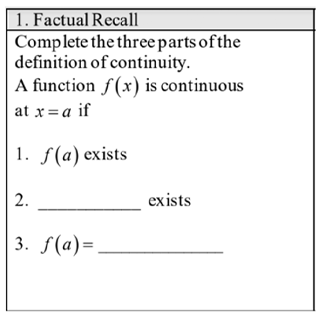
|
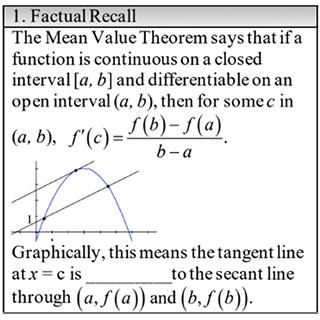
|
Since we started writing these as a review for the AP® exam, I wanted the “Factual Recall” to be straightforward and a reminder of what the topic is about.
In writing the “Carry Out a Procedure and Extend a Concept,” I wanted the difficulty level to increase from the 2nd task to the 5th task. As shown in the Power Rule Mixed Six displayed earlier, the 2nd task contains two problems that are typically easy if the student remembers the power rule. The 2nd task, as in the 1st task, serves as a review of the topic without getting too difficult. The 5th task, though, should be somewhat of a challenge to the students. In the case of the Power Rule Mixed Six, many students will struggle with how to apply the power rule in the “Extend a Concept” problem. Most would think that they need to proceed with the quotient rule, but it is not the most effective way to find the derivative.
The “Classify a Mathematical Object” task is sometimes tough to write. I’ve done matching, Venn diagrams, and other various classification items. Here is an example of one that uses a Venn diagram and one where the students are to circle the ones that meet the criteria given. In the MVT one to the right, the students had calculators to be able to graph the function over the given interval to make a decision about the hypotheses.
Examples of “Classifying a Mathematical Object” task:
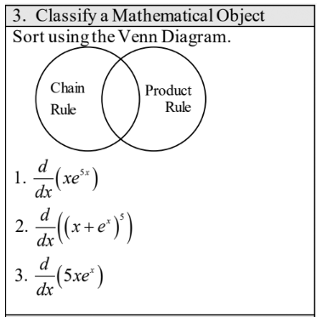
|
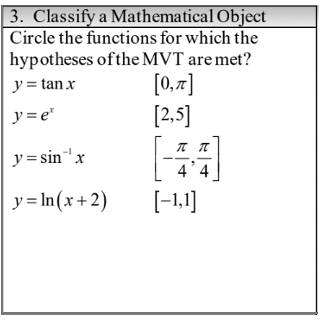
|
The top three tasks serve the purpose of getting the student into the content. The bottom three tasks should get the students to start thinking and talking about mathematics. Often, I had my students complete the top three tasks individually, then assign them to random groups at the VNPSs (aka white boards). They would first check their work for the top three tasks and make corrections if necessary. The students would then work on the bottom three tasks together.
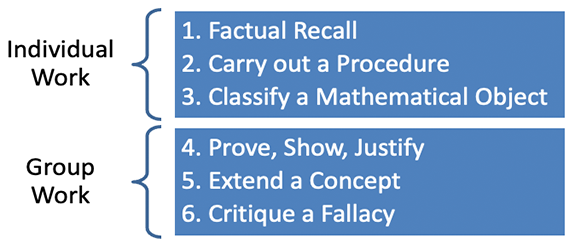
The “Prove, Show, Justify” ones are perfect for calculus. I really liked to show that the answer is ___. These tasks gave me the opportunity to have the students complete a problem like a multiple-choice question where the answer is in a form that might be different from what they first write.
I’ve already compared the tasks of “Carry Out a Procedure and Extend a Concept.” I really wanted the “Extend a Concept” to challenge the students.
When writing the “Critique a Fallacy,” I tried to imitate common mistakes that students make. Most teachers could write a book on the common errors that a student would make on a problem.
I know that these Mixed Six activities helped my AP® Calculus students during the review. In reflecting about these activities, I feel that they could also be used as warm-ups to start the day or exit tickets.
I hope you will check out the webinar Tony Record and I presented, if you want to learn more about these Mixed Six activities. In the on-demand version of the webinar, we discuss the concept behind a Mixed Six and talk about how to write one. We also go over a few samples from various math courses in the high school curriculum. If you want a challenge, I encourage you to try to write one. Go ahead, pick a topic in your math class and give it a try!
About the author: Vicki Carter is a retired math teacher splitting time between her home on an airport (yes, we have a hangar in the back yard) and her happy place on Black River near the coast of South Carolina. Although her grandchildren now get most of her attention, she still loves working with TI to provide resources, conference sessions and webinars. Carter retired in June of 2022 after 46 years at West Florence High School in Florence, South Carolina. She is a T³™ National Instructor. She also served as an Exam Leader at the 2022 AP® Calculus reading in Kansas City. She is a former co-chair of the AP® Calculus Development Committee.
AP® and College Board® are trademarks registered by the College Board, which is not affiliated with, and does not endorse, TI products. Policies subject to change. Visit www.collegeboard.org.
Tags:
Tagcloud
Archive
- 2025
- 2024
-
2023
- January (3)
- February (3)
- March (5)
- April (3)
- May (3)
- June (3)
- July (2)
-
August (6)
- 5 Ways to Spruce Up Your Classroom for Back to School
- Day of the Dog: Which Dog Is Roundest?
- Women Who Code: A TI Intern’s Fascinating STEM Journey
- 6 Sensational TI Resources to Jump-Start Your School Year
- 3 Back-to-School Math Activities to Reenergize Your Students
- A New School Year — A New You(Tube)!
- September (2)
- October (3)
- November (1)
- 2022
-
2021
- January (2)
- February (3)
- March (5)
-
April (7)
- Top Tips for Tackling the SAT® with the TI-84 Plus CE
- Monday Night Calculus With Steve Kokoska and Tom Dick
- Which TI Calculator for the SAT® and Why?
- Top Tips From a Math Teacher for Taking the Online AP® Exam
- Celebrate National Robotics Week With Supervised Teardowns
- How To Use the TI-84 Plus Family of Graphing Calculators To Succeed on the ACT®
- AP® Statistics: 6 Math Functions You Must Know for the TI-84 Plus
- May (1)
- June (3)
- July (2)
- August (5)
- September (2)
-
October (4)
- Transformation Graphing — the Families of Functions Modular Video Series to the Rescue!
- Top 3 Halloween-Themed Classroom Activities
- In Honor of National Chemistry Week, 5 “Organic” Ways to Incorporate TI Technology Into Chemistry Class
- 5 Spook-tacular Ways to Bring the Halloween “Spirits” Into Your Classroom
- November (4)
- December (1)
-
2020
- January (2)
- February (1)
- March (3)
- April (1)
- May (2)
- July (1)
- August (2)
- September (3)
-
October (7)
- Tips for Teachers in the time of COVID-19
- Top 10 Features of TI-84 Plus for Taking the ACT®
- TI Codes Contest Winners Revealed
- Best of Chemistry Activities for the Fall Semester
- Best of Biology Activities for the Fall Semester
- Best of Physics Activities for the Fall Semester
- Best of Middle Grades Science Activities
- November (1)
- December (2)
- 2019
-
2018
- January (1)
- February (5)
- March (4)
- April (5)
- May (4)
- June (4)
- July (4)
- August (4)
- September (5)
-
October (9)
- Art in Chemistry
- Which Texas Instruments (TI) Calculator for the ACT® and Why?
- Meet TI Teacher of the Month: Jessica Kohout
- Innovation in Biology
- Learning With Your Students
- A first-of-its-kind STEM strategy charts path to help educators
- #NCTMregionals Hartford 2018 Recap
- The Math Behind “Going Viral”
- Real-World Applications of Chemistry
-
November (8)
- Testing Tips: Using Calculators on Class Assessments
- Girls in STEM: A Personal Perspective
- 5 Teachers You Should Be Following on Instagram Right Now
- Meet TI Teacher of the Month: Katie England
- End-of-Marking Period Feedback Is a Two-Way Street
- #NCTMregionals Kansas City 2018 Recap
- Slope: It Shouldn’t Just Be a Formula
- Hit a high note exploring the math behind music
- December (5)
- 2017
- 2016
- 2015
